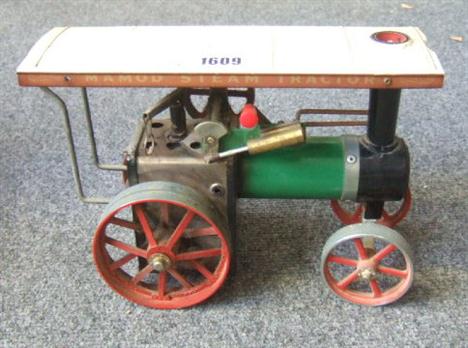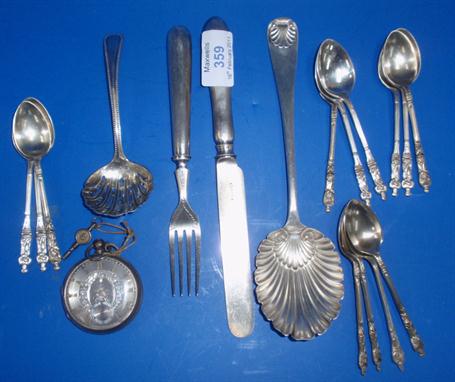A Collection of Hornby `O` Gauge Trains and Accessories, including an electric 0-4-0 locomotive No.460, in LNER green livery (a/f), a clockwork 0-4-0 locomotive No.82011, in black BR livery, four bogie coaches in plain blue livery, lamp, Astra traffic light, quantity of track etc., in two boxes; A Boxed Mamod Traction Engine T.E.1 and an S.E.L Power Press
186049 Preisdatenbank Los(e) gefunden, die Ihrer Suche entsprechen
186049 Lose gefunden, die zu Ihrer Suche passen. Abonnieren Sie die Preisdatenbank, um sofortigen Zugriff auf alle Dienstleistungen der Preisdatenbank zu haben.
Preisdatenbank abonnieren- Liste
- Galerie
-
186049 Los(e)/Seite
A gentleman`s pocket watch, the key wind movement and white enamelled dial signed H Stone, Leeds with Roman numerals and subsidiary seconds dial in engine turned silver case, Birmingham 1911, together with another smaller .925 silver cased keyless wind pocket watch (in 1939 dated leather purse) (3)
A large quantity of Model Engineer magazines contained in numerous box files and loose circa 1985-2008, together with ten volumes "The Model Engineer and Amateur Electrician" circa 1900-1905, two further volumes 1933 and 1941, BRIAN HOLLINGSWORTH LBSC-"His Life and Locomotives", various other related titles including one volume "Sterling Cycle Engines" AFTER GEOFFREY WHEELER and a pair of steam engine prints
Industrial revolution – John Rastrick autograph letter signed dated Steam Mill Norwich May 30th 1807 concerning Rastrick’s financial position and his continuing wrangling against the establishment but also reporting on his industrial developments: ‘...the people in Norpeth encouraged me to build a mill to work by steam and that they would take shairs – upon the grate promishes ...I sett to work & built a engine & mill on my own premises – never did anything come forward that releaved that neighbourhood so much in the time of distress the poor was in...I am altering & much improving a large steam mill here [in Norwich] for manufacturing flour- is nearly finished at what I meen to stop to do at this time – this is a large City but in a low way the traid is very poor...’
Scale model after Alphonse de Polignac`s curved cylinder engine design, first published in 1875, the horizontal double-ended cylinder with a swinging piston rod supported on a triangular frame, and side valve, the crank with two 100m flywheels, on metal base plate and wooden frame, length 3cm. * One-fifth scale drawings of de Polignac`s design were made in the 1990`s by Anthony Mount, the castings were made by Bruce Engineering (Polly Model Engineering Ltd)
A small French Empire ormolu figural timepiece Juer, Anouleme, early 19th century The fusee pocket watch movement with verge escapement, finely finished lobed baluster pillars, visible rack regulation and foliate pierced silvered balance bridge, the backplate signed Juer a Anouleme, with circular white Arabic numeral dial within engine turned ropetwist bezel set into a case with figure of a young girl wearing feather headress playing a tambourine stood beside the movement housed in a pedestal supporting a basket finial, on plinth base fronted with a mount cast with dolphins and on turned feet, 16cm high. DESCRIPTION TO BE READ IN CONJUNCTION WITH ‘IMPORTANT NOTES REGARDING THE CATALOGUING OF CLOCKS’ printed in the sale catalogue or available from the auctioneers on request.
A French Empire ormolu figural mantel timepiece Laine, Paris, early 19th century The eight-day movement with anchor escapement and silk suspension, the circular silvered Roman numeral dial with engine turned centre, signed LAINE, PARIS to upper margin and with laurel cast bezel, the case with figure of cupid playing a lyre stood beside the movement housed within a rectangular pedestal fronted with foliate sprays and supporting a basket of flowers, the opposing side with rose entwined bow-and-quiver chased mount incorporating a flaming torch, the plinth base fronted with trophies emblematic of music and love, on engine turned beehive shaped feet, 30cm high. DESCRIPTION TO BE READ IN CONJUNCTION WITH ‘IMPORTANT NOTES REGARDING THE CATALOGUING OF CLOCKS’ printed in the sale catalogue or available from the auctioneers on request.
A French Charles X ormolu mounted small mahogany portico mantel clock with subsidiary seconds dial Robert, Paris, 2nd quarter of the 19th century The eight-day movement with ornate cast lyre shaped `gridiron` pendulum and circular silvered Roman numeral dial with engine turned rosette to centre and recessed subsidiary seconds dial at 12 o`clock, the movement set between the columns of a portico-shaped case with moulded cornice and applied scroll cast gilt mount to entablature above four columns with crisply cast capitals and bases, on stepped plinth base with conforming mount to apron and compressed bun feet, 34.5cm high. DESCRIPTION TO BE READ IN CONJUNCTION WITH ‘IMPORTANT NOTES REGARDING THE CATALOGUING OF CLOCKS’ printed in the sale catalogue or available from the auctioneers on request. The current lot was probably made by Henri Robert who is recorded in Baillie, G.H. Watchmakers & Clockmakers of the World as born in 1794, he was an eminent maker who published two books; L`Art de connaitre les pendules et les montres in 1841and Etudes sur diverses questions d`horlogerie in 1849. He died in 1874.
A Meissen ‘blanc de chine’ porcelain figural mantel timepiece in the Louis XVI taste Unsigned, late 19th century and later Now with French eight-day movement with platform lever escapement and engine turned circular silvered Roman numeral dial, set into a rectangular case with lovebird surmount and foliate bud finials above floral encrusted swags, the apron with key pattern scroll terminals, beside figure of cupid resting, the whole on scroll decorated plinth base with foliate panel to apron and on bun feet (minor losses to porcelain), 30cm high. DESCRIPTION TO BE READ IN CONJUNCTION WITH ‘IMPORTANT NOTES REGARDING THE CATALOGUING OF CLOCKS’ printed in the sale catalogue or available from the auctioneers on request.
A fine George III green japanned eight-day longcase clock Henry Hindley, York, mid 18th century The four double-baluster turned pillar movement with concealed clicks to the barrels, gravity fed rack and bell striking, long crutch for the original heavy-bob pendulum and six-spoke wheel crossings throughout, the 12 inch brass break-arch dial with subsidiary seconds ring to the richly matted centre within applied silvered Roman numeral chapter ring with Arabic five minutes and signed Hindley, York to lower edge, the angles with rococo scroll cast spandrels, beneath arch with large diameter calendar ring flanked by conforming mounts, in a green ground gilt decorated case with concave sided pediment above three-quarter pilasters to hood door, break-arch trunk door decorated in raised polychrome and gilt with oriental figures within a terrace garden landscape above a European man o’ war, the plinth similarly decorated with a leaping dear above moulded double skirt base, 236cm (7ft 9ins) high. DESCRIPTION TO BE READ IN CONJUNCTION WITH ‘IMPORTANT NOTES REGARDING THE CATALOGUING OF CLOCKS’ printed in the sale catalogue or available from the auctioneers on request. Henry Hindley was born in Great Harwood, near Blackburn, Lancashire 1699, little is known about his early life, however by the mid 1720’s he was making clocks in Wigan where he repaired the church clock in 1726. Hindley moved with his young family (including his son, Joseph born 1728) to the prosperous city of York where, after making clocks for the Mansion House and Guildhall, he gained his Freedom of the city in 1732. Hindley’s talents were such that he equipped his workshop with tools of his own design including an important dividing and wheel cutting engine, a screw cutting lathe and a fusee engine. As well as domestic clocks Hindley received commissions for several turret clocks including York Minster and supplied a range of scientific instruments including two important equatorial telescopes for the Duke of Norfolk and William Constable. By the 1760’s Hindley’s health had deteriorated to the extent that an ever increasing proportion of the business was handled by his son Joseph. Henry died in 1771 with his son and successor Joseph unfortunately dying just three years later in 1774, before he had had the opportunity to stamp his own mark on the family firm. Hindley’s work demonstrates a highly inventive exacting approach with each clock perhaps varying in some way to its predecessor ensuring constant refinement in design and layout. The quality of the finish of his work is generally exceptional being comparable to the best London makers of the period which is why many collector’s refer to Hindley as ‘the Tompion of the North’. The movement of the current lot is a fine example of Hindley’s work exhibiting inventive details such as the cranked pumping mechanism for the calendar dial, gravity fed rack striking, concealed clicks to the barrels and combined hammer spring and stop. The wheelwork is perhaps a little unusual having six-spoke crossings throughout with finely turned collets. The large bob pendulum with lozenge shaped slot for the slider is also noteworthy.
A Georgian silver snuff box, by Joseph Ash, London 1811, the cover with two horses and jockeys at full gallop, within a stiff leaf border, and with engine turning to the base, traces of gilding, 7.5cm long; with a silver vesta case, Birmingham 1913, engraved with leaf scrolls; 121.9g (3.9 oz) gross
-
186049 Los(e)/Seite





















































